The serpentine belt is responsible for transferring power from the engine to the car’s various components. It is a heavy-duty belt with teeth to grip and drive pulleys.
Some serpentine belts are made with a stretchable material that makes them loose. This is because they are designed to be loose on the engine and tight around the pulleys.
You might have to replace your serpentine belt if it is too loose or tight. You should also check it for any visible damage, such as cracks or fraying.
Many things can cause a loose serpentine belt. The most common causes are that the belt has gone through too much wear and tear or has not been properly tightened.
If you notice that your serpentine belt is loose or not tight enough, this could be a sign that it needs to be replaced soon. You should have it inspected by a mechanic as soon as possible before any more damage can happen to your engine.
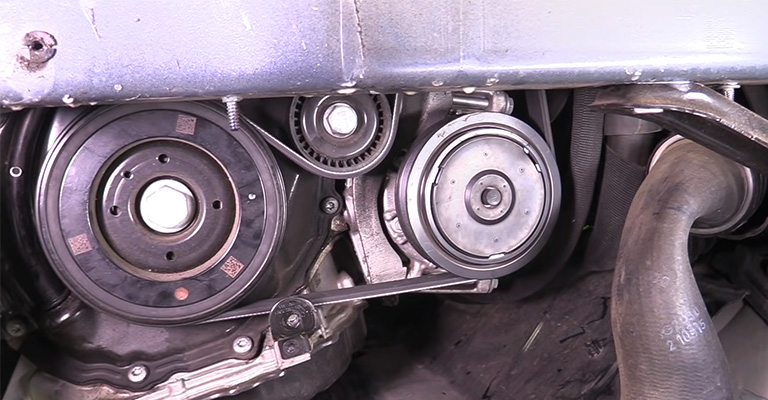
Why Is My New Serpentine Belt Loose?
A serpentine belt must be constantly tensioned to prevent it from coming off. The belt can come off if the alignment is not aligned. It is possible that the tensioner is out of alignment and not applying enough tension to the belt.
You should have a mechanic check the tensioner and replace it if necessary. If there is a loose idler pulley or an out-of-adjustment tensioner pulley, it may be the cause.
In a serpentine belt pattern, the tensioner pulley is used to adjust belt tension as needed by increasing or decreasing the tension on the belt. A loose tensioner pulley or a belt that has been out of adjustment could cause the belt to fall off.
The Problems With Belts And Tensioners That Can Cause Them To Break Or Produce Noises
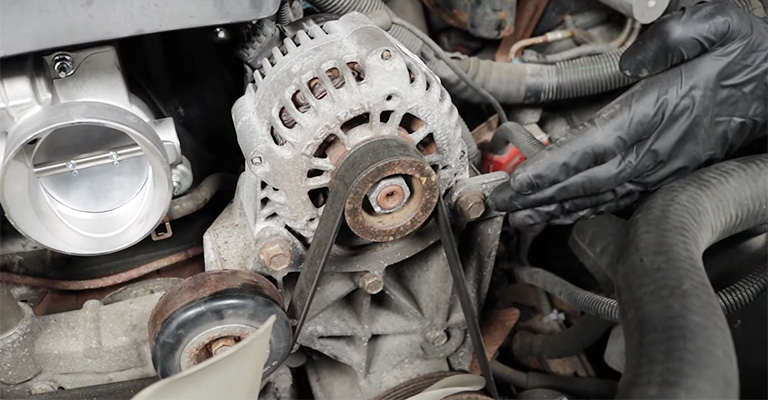
Generally, alternator failure is caused by the front and rear bearings that carry the armature; the belt is directly responsible for the bearings’ health. Having a too tight belt will cause excessive side loads and cause the bearings to overheat.
Consequently, the alternator will make noise, lose power, and even seize. The alternator will slip if the belt is too loose. Alternators and batteries may have to work harder due to this slipping. The following are some of the most common problems:
Wear And Tear On A Regular Basis
Serpentine belts with ribbed sides now have soft felt-like surfaces. A cracked belt can be seen in the photo below; as the belt rubber wears out, it hardens and cracks. Wearing out a belt causes it to stretch and lose tension.
From time to time, the belt slips due to this. The engine might squeal or chirp under the hood during wet weather or when the engine is started in the morning.
Tensioner Bearings Or Idler Pulleys That Are Noisy
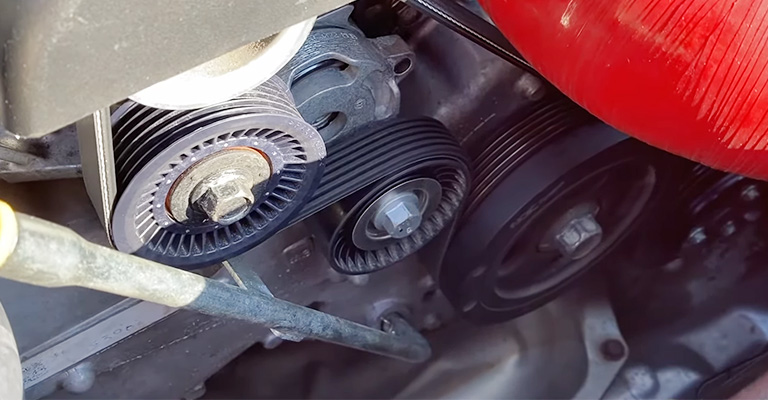
The photo shows a free-spinning pulley used by many cars to route serpentine belts. Idler pulleys are used for this purpose. There is a small bearing that makes it a spin.
If the bearing wears out, it will make a whining or whirring noise. Because many belt-driven devices can make similar noises, diagnosing this one may take some time.
The Belt Pulley Is Misaligned
There are several pulleys on which a serpentine belt runs. The belt will squeal if, for some reason, any belt-driven device or tensioner pulley is not aligned with it.
A new belt is often discovered squealing or wearing out fast after it has been replaced. The belt wears out more quickly on one side of the machine, which is one of the symptoms of this problem.
There Is An Issue With The Manual Belt Tension
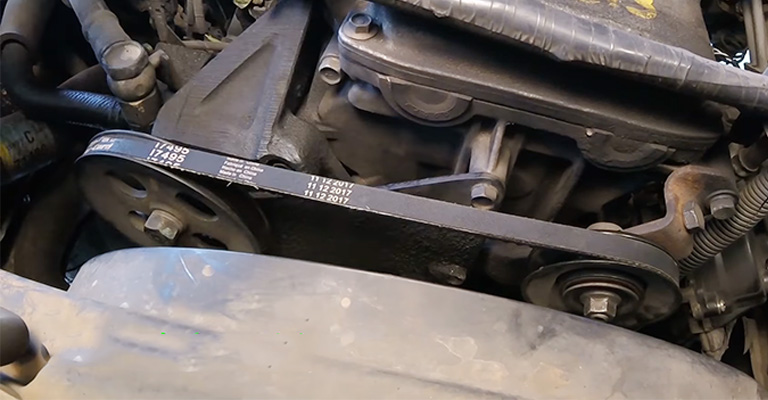
There are some cars that allow the belt tension to be adjusted manually as it stretches over time. If the tension is not adjusted in time, the belt will slip.
There is probably nothing more annoying than a car with an old Japanese or Korean engine that makes an awful screeching noise when it is started.
Hydraulic Belt Tensioner Problems
The tension is maintained by a little “shock absorber” in place of spring in many cars with hydraulic serpentine belt tensioners. There is also a possibility of failure.
If the engine runs, you may hear a rattling noise from the belt area or a leak from the tensioner. In many cars, this item fails frequently.
Bad Spring-Loaded Automatic Belt Tensioner
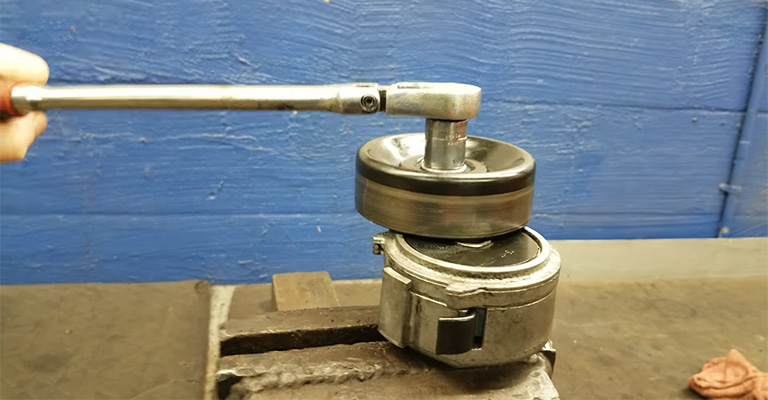
Any belt needs to be tensioned correctly. Old spring-loaded automatic belt tensioners often become weak due to seized-up or worn parts. Serpentine belts tend to slip without proper tension.
This will cause the belt to wear out more quickly. The tensioner of a serpentine belt can seize up, causing the belt to fall off.
When the steering wheel is turned to one side or the engine is started, a loose serpentine belt will squeal loudly. It is also possible for a serpentine belt to keep slipping off the pulley if the tensioner is not working correctly.
Oil Leaks
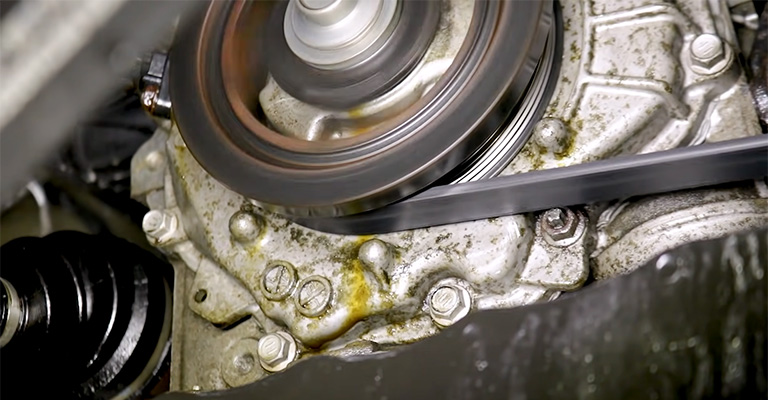
In some cases, an engine develops oil leaks around the belt area, soaking the belt in oil, as shown in the photo. There is a possibility that oil or coolant can damage the serpentine belt or timing belt very quickly.
An engine with an oil leak around the belt area had a new serpentine belt last less than a week. The installation of a new belt would be pointless in this case. The first thing that needs to be done is to fix the oil leak.
Problems with Serpentine Belts & How to Fix Them
A misaligned serpentine belt or a defective tensioner is usually the cause of serpentine belt wear. A belt inspection can help you diagnose the problem- both before and after the belt is removed- even if you can’t hear the problem.
Fraying
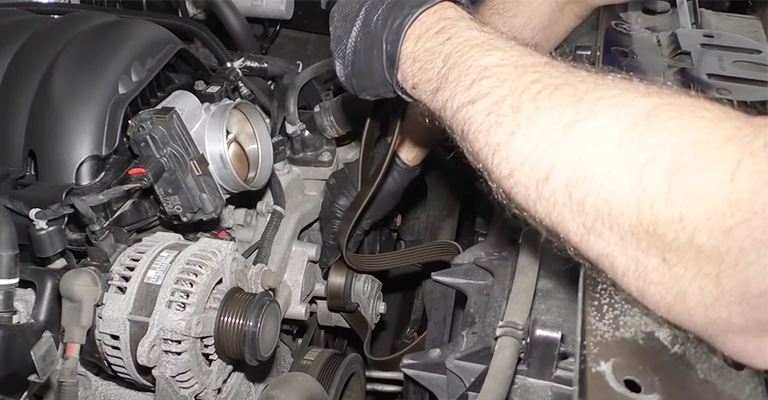
A belt that frays at the edge is usually a sign that the pulleys are misaligned. An accessory drive pulley side scrapes on the belt’s top edge when it is not properly positioned on the pulley, eventually fraying it.
In most cases, you can detect this by observing the wear on the edge of the belt. Pulleys and belts rub against each other, causing a thumping or rubbing sound.
Glazing
It is caused by the belt slipping, and the belt forms glazing on its edges, ridges, or grooves. There can be slipping due to a loss of belt tension (or a weak tensioner) or misalignment of the pulleys.
Whenever the belt slips off its track, friction between the belt and accessory drive pulleys leads to belt overheating. Squealing noises usually indicate that it’s time to change your light bulb.
Excessive Cracking
A person’s age is usually a contributing factor to excessive cracking. Rubber becomes drier and less pliable with age and use, making serpentine belts more prone to cracking as they age.
A defective tensioner, however, can also cause cracking. Keeping the belt tight on the pulleys is the tensioner’s job, which is spring-loaded. A loose belt should always be checked to see if the tensioner is working properly or if it starts slipping.
How to Tighten a Serpentine Belt?
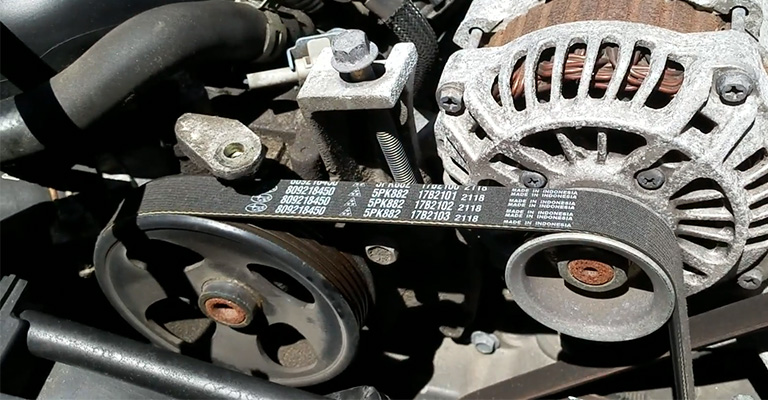
Your alternator will not charge your battery properly if your serpentine belt is too loose, and your accessories may also not work properly. You should tighten your belt to fix this problem.
Step 1
The serpentine belt tension can be adjusted by opening the hood and locating the adjustment screw. There is usually a wing nut on this screw, located near the alternator.
Step 2
Apply tension by placing the socket end of the socket wrench over the wing-nut and turning clockwise. The wing nut will most likely not be able to be adjusted by hand, so check your socket set for a socket that will fit snugly over the nut and tighten it, thereby adding more tension to the serpentine belt.
Step 3
Make sure the belt is tensioned periodically. Grab any part of the belt between two pulleys with your fingers. For most vehicles, the belt should have about 1/4 inch of play.
Step 4
Make sure the belt tension is correct a second time. The belt should be examined in motion after the vehicle has been started. The alternator will whine if there is a whine coming from it.
An alternator that whines or pulses indicate that the belt tension is too tight, which damages the alternator. Recheck the tension by loosening the belt and turning the adjustment screw counterclockwise.
Step 5
Make sure everything is in order. All your accessories should be able to provide continuous power. Make sure all of your accessories are turned on at the same time. A belt that is not tensioned correctly will result in abnormalities.
What Happens If A Serpentine Belt Breaks?
An automobile that breaks its serpentine belt must be towed without being able to drive. Unless a serpentine belt is installed, the engine will overheat if the water pump is not working.
If it breaks, other parts can be damaged as well as the belt. There have been cases where ripped belts have caused broken radiator shrouds and ripped coolant hoses. An under-the-hood slapping, squealing, or knocking noise is a sign of a broken serpentine belt.
It is also possible that the battery-shaped warning light on the charging system will illuminate because the alternator will stop charging the battery. A power steering pump that relies on hydraulics will result in stiff steering.
How Often Should Serpentine Belts Be Replaced?
The lifespan of a serpentine belt can range from 30,000 to more than 100,000 miles. Almost all car manufacturers recommend inspecting serpentine belts during regular maintenance rather than specifying intervals for serpentine belt replacement.
In addition to checking for cracks, splits, damaged edges, missing chunks, glazing, and other signs of wear, a mechanic will also inspect your vehicle’s oil.
When a belt is worn out, it’s easy to tell. When a belt wears out, it needs to be replaced. It is also necessary to replace serpentine belts that have become soaked in oil or are stretched.
The Cost Of Replacing A Serpentine Belt
You must replace both belts simultaneously if your car has two belts, as this will save you labor costs. In addition, serpentine belt replacement is a good idea before a long drive. The replacement cost of a serpentine belt range from $18 to $75 for the part and $50 to $150 for the labor.
Final Words
When your drive belt is loose, you may have trouble powering your vehicle’s accessories, such as air conditioning, power steering, or alternator, or you may even experience motor damage.
Most vehicles can adjust drive belt tension with simple hand tools, but some require special tools to maintain proper tension.

Leave a Reply